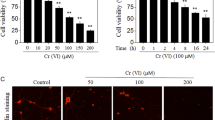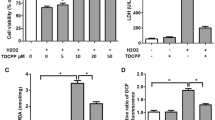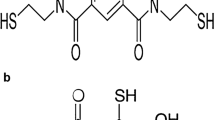Abstract
Increasing exploration of rare-earth elements (REEs) has resulted in a high REEs’ exposure risk. Owing to their persistence and accumulation of REEs in the environment, their adverse effects have caused widespread concern. However, limited toxicological data are available for the adverse effects of yttrium (Y) and its underlying mechanisms of action. In the present study, H9c2 cardiomyocytes were used in vitro model to investigate the cardiotoxicity of yttrium chloride (YCl3). Results show that YCl3 treatment resulted in reactive oxygen species (ROS) overproduction, decrease in ∆Ψm, and DNA damage. Mechanistically, we detected expression levels of protein in response to cellular DNA damage and antioxidative defense. Results indicated that the phosphorylation of histone H2AX remarkably increased in a dose-dependent manner. At a high YCl3-exposure concentration (120 μM), specific DNA damage sensors ATM/ATR-Chk1/Chk2 were significantly decreased. The protein levels of key antioxidant genes Nrf2/PPARγ/HO-1 were also remarkably inhabited. Additionally, the antioxidant N-acetyl-l-cysteine (NAC) pretreatment promoted the activation of antioxidative defense Nrf2/PPARγ signaling pathways, and prevented the production of cellular ROS, thus protecting the DNA from cleavage. Altogether, our findings suggest that YCl3 can induce DNA damage through causing intracellular ROS overproduction and inhibition of antioxidative defense, leading to cytotoxicity in H9c2 cardiomyocytes.





Similar content being viewed by others
Abbreviations
- ATM:
-
Ataxia telangiectasia mutated
- ATR:
-
Ataxia telangiectasia mutated and Rad3-related
- Bax:
-
Bcl-2 associated X
- Bcl-2:
-
B-cell lymphoma-2
- Caspase-3:
-
Cysteine aspartate-specific protease 3
- CCK-8:
-
Cell counting kit-8
- Chk1:
-
Checkpoint kinase 1
- Chk2:
-
Checkpoint kinase 2
- DAPI:
-
4',6-Diamidino-2-phenylindole
- DCFH-DA:
-
2′,7′-Dichlorofluorescin diacetate
- DDR:
-
DNA damage response
- Fpg:
-
Formamidopyrimidine DNA glycosylase
- HO-1:
-
Heme oxygenase-1
- JC-1:
-
5,5′,6,6′-Tetrachloro-1,1′,3,3′-tetraethylbenzimidazolylcarbocyanine iodide
- LC50 :
-
The median lethal concentration
- MDA:
-
Malondialdehyde
- GSH:
-
Glutathione
- NAC:
-
N-Acetyl-cysteine
- Nrf2:
-
Nuclear factor erythroid 2-related factor 2
- PPARγ:
-
Peroxisome proliferator-activated receptor γ
- REEs:
-
Rare-earth elements
- ROS:
-
Reactive oxygen species
- SOD:
-
Superoxide dismutase
- γ-H2AX:
-
Phosphorylation of histone H2AX at Ser139
- ∆Ψm:
-
Mitochondrial membrane potential
References
Armstrong SA, Schultz CW, Azimi-Sadjadi A, Brody JR, Pishvaian MJ (2019) ATM dysfunction in pancreatic adenocarcinoma and associated therapeutic implications. Mol Cancer Ther 18(11):1899–1908
Barakos G, Gutzmer J, Mischo H (2016) Strategic evaluations and mining process optimization towards a strong global REE supply chain. J Sustain Min 15(1):26–35
Bonner WM, Redon CE, Dickey JS, Nakamura AJ, Sedelnikova OA, Solier S, Pommier Y (2008) GammaH2AX and cancer. Nat Rev Cancer 8(12):957–967
Cardon PY, Triffault-Bouchet G, Caron A, Rosabal M, Fortin C, Amyot M (2019) Toxicity and subcellular fractionation of yttrium in three freshwater organisms: Daphnia magna, Chironomus riparius, and Oncorhynchus mykiss. ACS Omega 4(9):13747–13755
Cordelli E, Bignami M, Pacchierotti F (2021) Comet assay: a versatile but complex tool in genotoxicity testing. Toxicol Res (camb) 10(1):68–78
De Michelis I, Ferella F, Varelli EF, Vegliò F (2011) Treatment of exhaust fluorescent lamps to recover yttrium: experimental and process analyses. Waste Manag 31(12):2559–2568
Ding Y, Tian Y, Zeng Z, Shuai P, Lan H, Zhu X, Zhong Y, Wu L, Fan X (2017) YCl3 promotes neuronal cell death by inducing apoptotic pathways in rats. Biomed Res Int 2017:2183658
Fu Y, Li F, Xu T, Cai S, Chu W, Qiu H, Sha S, Cheng G, Xu Q (2014) Bioaccumulation, subcellular, and molecular localization and damage to physiology and ultrastructure in Nymphoides peltata (Gmel.) O. Kuntze exposed to yttrium. Environ Sci Pollut Res Int 21(4):2935–2942
Hardas SS, Sultana R, Warrier G, Dan M, Wu P, Grulke EA, Tseng MT, Unrine JM, Graham UM, Yokel RA et al (2014) Rat hippocampal responses up to 90 days after a single nanoceria dose extends a hierarchical oxidative stress model for nanoparticle toxicity. Nanotoxicology 8(Suppl 1):155–166
Harper JW, Elledge SJ (2007) The DNA damage response: ten years after. Mol Cell 28(5):739–745
Hayashi S, Usuda K, Mitsui G, Shibutani T, Dote E, Adachi K, Fujihara M, Shimbo Y, Sun W, Kono R et al (2006) Urinary yttrium excretion and effects of yttrium chloride on renal function in rats. Biol Trace Elem Res 114(1–3):225–235
Hirano S, Kodama N, Shibata K, Suzuki KT (1990) Distribution, localization, and pulmonary effects of yttrium chloride following intratracheal instillation into the rat. Toxicol Appl Pharmacol 104(2):301–311
Hirano S, Kodama N, Shibata K, Suzuki KT (1993) Metabolism and toxicity of intravenously injected yttrium chloride in rats. Toxicol Appl Pharmacol 121(2):224–232
Hung SY, Liou HC, Kang KH, Wu RM, Wen CC, Fu WM (2008) Overexpression of heme oxygenase-1 protects dopaminergic neurons against 1-methyl-4-phenylpyridinium-induced neurotoxicity. Mol Pharmacol 74(6):1564–1575
Innocenzi V, De Michelis I, Kopacek B, Vegliò F (2014) Yttrium recovery from primary and secondary sources: a review of main hydrometallurgical processes. Waste Manag 34(7):1237–1250
Itoh K, Wakabayashi N, Katoh Y, Ishii T, Igarashi K, Engel JD, Yamamoto M (1999) Keap1 represses nuclear activation of antioxidant responsive elements by Nrf2 through binding to the amino-terminal Neh2 domain. Genes Dev 13(1):76–86
Janssen RP, Verweij W (2003) Geochemistry of some rare earth elements in groundwater, Vierlingsbeek, The Netherlands. Water Res 37(6):1320–1350
Jiang DG, Yang J, Zhang S, Yang DJ (2012) A survey of 16 rare earth elements in the major foods in China. Biomed Environ Sci 25(3):267–271
Khan AM, Bakar NKA, Bakar AFA, Ashraf MA (2017) Chemical speciation and bioavailability of rare earth elements (REEs) in the ecosystem: a review. Environ Sci Pollut Res Int 24(29):22764–22789
Ladeira C, Koppen G, Scavone F, Giovannelli L (2019) The comet assay for human biomonitoring: effect of cryopreservation on DNA damage in different blood cell preparations. Mutat Res Genet Toxicol Environ Mutagen 843:11–17
Lai IH, Chang CD, Shih WL (2019) Apoptosis induction by pseudorabies virus via oxidative stress and subsequent DNA damage signaling. Intervirology 62(3–4):116–123
Lee C (2017) Collaborative power of Nrf2 and PPARgamma activators against metabolic and drug-induced oxidative injury. Oxid Med Cell Longev 2017:1378175
Li CX, Ma C, Fang HQ, Zhi Y, Yu Z, Xu HB, Jia XD (2015) Neurobehavioral assessment of rats exposed to yttrium nitrate during development. Biomed Environ Sci 28(4):281–290
Liang T, Li K, Wang L (2014) State of rare earth elements in different environmental components in mining areas of China. Environ Monit Assess 186(3):1499–1513
Liu J, Hou J, Xia ZY, Zeng W, Wang X, Li R, Ke C, Xu J, Lei S, Xia Z (2013) Recombinant PTD-Cu/Zn SOD attenuates hypoxia-reoxygenation injury in cardiomyocytes. Free Radic Res 47(5):386–393
Liu WS, Guo MN, Liu C, Yuan M, Chen XT, Huot H, Zhao CM, Tang YT, Morel JL, Qiu RL (2019) Water, sediment and agricultural soil contamination from an ion-adsorption rare earth mining area. Chemosphere 216:75–83
Ludke AR, Sharma AK, Akolkar G, Bajpai G, Singal PK (2012) Downregulation of vitamin C transporter SVCT-2 in doxorubicin-induced cardiomyocyte injury. Am J Physiol Cell Physiol 303(6):C645-653
Mancheri NA (2015) World trade in rare earths, Chinese export restrictions, and implications. Resour Policy 46:262–271
Marubashi K, Hirano S, Suzuki KT (1998) Effects of intratracheal pretreatment with yttrium chloride (YCl3) on inflammatory responses of the rat lung following intratracheal instillation of YCl3. Toxicol Lett 99(1):43–51
Mates JM, Perez-Gomez C, Nunez de Castro I (1999) Antioxidant enzymes and human diseases. Clin Biochem 32(8):595–603
Matsuoka S, Ballif BA, Smogorzewska A, McDonald ER 3rd, Hurov KE, Luo J, Bakalarski CE, Zhao Z, Solimini N, Lerenthal Y et al (2007) ATM and ATR substrate analysis reveals extensive protein networks responsive to DNA damage. Science 316(5828):1160–1166
Mestre NC, Sousa VS, Rocha TL, Bebianno MJ (2019) Ecotoxicity of rare earths in the marine mussel Mytilus galloprovincialis and a preliminary approach to assess environmental risk. Ecotoxicology 28(3):294–301
Neumann J, Boerries M, Kohler R, Giaisi M, Krammer PH, Busch H, Li-Weber M (2014) The natural anticancer compound rocaglamide selectively inhibits the G1-S-phase transition in cancer cells through the ATM/ATR-mediated Chk1/2 cell cycle checkpoints. Int J Cancer 134(8):1991–2002
Nikolova T, Dvorak M, Jung F, Adam I, Kramer E, Gerhold-Ay A, Kaina B (2014) The gammaH2AX assay for genotoxic and nongenotoxic agents: comparison of H2AX phosphorylation with cell death response. Toxicol Sci 140(1):103–117
Pagano G, Thomas P, Di Nunzio A, Trifuoggi M (2019) Human exposures to rare earth elements: present knowledge and research prospects. Environ Res 171:493–500
Perry JJ, Shin DS, Getzoff ED, Tainer JA (2010) The structural biochemistry of the superoxide dismutases. Biochim Biophys Acta 1804(2):245–262
Pezzini I, Marino A, Del Turco S, Nesti C, Doccini S, Cappello V, Gemmi M, Parlanti P, Santorelli F, Mattoli V et al (2017) Cerium oxide nanoparticles: the regenerative redox machine in bioenergetic imbalance. Nanomedicine (lond) 12(4):403–416
Pi J, Qu W, Reece J, Kumagai Y, Waalkes M (2003) Transcription factor Nrf2 activation by inorganic arsenic in cultured keratinocytes: involvement of hydrogen peroxide. Exp Cell Res 290(2):234–245
Polvani S, Tarocchi M, Galli A (2012) PPARgamma and oxidative stress: con(beta) catenating NRF2 and FOXO. PPAR Res 2012:641087
Poprac P, Jomova K, Simunkova M, Kollar V, Rhodes CJ, Valko M (2017) Targeting free radicals in oxidative stress-related human diseases. Trends Pharmacol Sci 38(7):592–607
Schalow BJ, Courcelle CT, Courcelle J (2011) Escherichia coli Fpg glycosylase is nonrendundant and required for the rapid global repair of oxidized purine and pyrimidine damage in vivo. J Mol Biol 410(2):183–193
Scheffel M, Scurti G, Simms P, Garrett-Mayer E, Mehrotra S, Nishimura M, Voelkel-Johnson C (2016) Efficacy of adoptive T-cell therapy is improved by treatment with the antioxidant N-acetyl cysteine, which limits activation-induced T-cell death. Cancer Res 76(20):6006–6016
Shiloh Y (2003) ATM and related protein kinases: safeguarding genome integrity. Nat Rev Cancer 3(3):155–168
Shin S, Kim H, Rim K (2019) Worker safety in the rare earth elements recycling process from the review of toxicity and issues. Saf Health Work 10(4):409–419
Siwek M, Sowa-Kucma M, Dudek D, Styczen K, Szewczyk B, Kotarska K, Misztakk P, Pilc A, Wolak M, Nowak G (2013) Oxidative stress markers in affective disorders. Pharmacol Rep 65(6):1558–1571
Susin S, Lorenzo H, Zamzami N, Marzo I, Snow B, Brothers G, Mangion J, Jacotot E, Costantini P, Loeffler M et al (1999) Molecular characterization of mitochondrial apoptosis-inducing factor. Nature 397(6718):441–446
Takahashi Y, Kanemaru K, Imai S, Miyoshi N, Kawanai T, Oyama Y (2012) Yttrium decreases the intracellular Zn2+ concentration in rat thymocytes by attenuating a temperature-sensitive Zn2+ influx. Environ Toxicol Pharmacol 34(2):574–578
Thomas PJ, Carpenter D, Boutin C, Allison JE (2014) Rare earth elements (REEs): effects on germination and growth of selected crop and native plant species. Chemosphere 96:57–66
Toya T, Takata A, Otaki N, Takaya M, Serita F, Yoshida K, Kohyama N (2010) Pulmonary toxicity induced by intratracheal instillation of coarse and fine particles of cerium dioxide in male rats. Ind Health 48(1):3–11
Trifuoggi M, Pagano G, Guida M, Palumbo A, Siciliano A, Gravina M, Lyons DM, Buric P, Levak M, Thomas PJ et al (2017) Comparative toxicity of seven rare earth elements in sea urchin early life stages. Environ Sci Pollut Res Int 24(25):20803–20810
Turra C (2018) Sustainability of rare earth elements chain: from production to food—a review. Int J Environ Health Res 28(1):23–42
Valcheva-Traykova M, Saso L, Kostova I (2014) Involvement of lanthanides in the free radicals homeostasis. Curr Top Med Chem 14(22):2508–2519
Wang B, Yan L, Huo W, Lu Q, Cheng Z, Zhang J, Li Z (2017) Rare earth elements and hypertension risk among housewives: a pilot study in Shanxi Province, China. Environ Pollut 220:837–842
Witek P, Korga A, Burdan F, Ostrowska M, Nosowska B, Iwan M, Dudka J (2016) The effect of a number of H9C2 rat cardiomyocytes passage on repeatability of cytotoxicity study results. Cytotechnology 68(6):2407–2415
Xiong L, Huang J, Gao Y, Gao Y, Wu C, He S, Zou L, Yang D, Han Y, Yuan Q et al (2021) Sodium arsenite induces spatial learning and memory impairment associated with oxidative stress and activates the Nrf2/PPARgamma pathway against oxidative injury in mice hippocampus. Toxicol Res (camb) 10(2):277–283
Zhao C, Shi X, Xie S, Liu W, He E, Tang Y, Qiu R (2019) Ecological risk assessment of neodymium and yttrium on rare earth element mine sites in Ganzhou, China. Bull Environ Contam Toxicol 103(4):565–570
Funding
This work was supported by grants from the National Natural Science Foundation of China (81460504 and 81960599), the Science and Technology Project funded by the Education Department of Jiangxi Province (GJJ150940 and GJJ201525), the Open Project of Key Laboratory of Prevention and Treatment of Cardiovascular and Cerebrovascular Diseases, Ministry of Education (XN201901 and XN202028), the Project of Scientific and Technological Innovation Team of Gannan Medical University (TD201801), and the Doctor Initial Funding for Gannan Medical University (QD201503).
Author information
Authors and Affiliations
Corresponding author
Ethics declarations
Conflict of interest
The authors declare that there are no conflicts of interest regarding the publication of this paper.
Additional information
Publisher's Note
Springer Nature remains neutral with regard to jurisdictional claims in published maps and institutional affiliations.
Supplementary Information
Below is the link to the electronic supplementary material.
Rights and permissions
About this article
Cite this article
Xiong, L., Huang, J., Wang, S. et al. Yttrium chloride-induced cytotoxicity and DNA damage response via ROS generation and inhibition of Nrf2/PPARγ pathways in H9c2 cardiomyocytes. Arch Toxicol 96, 767–781 (2022). https://doi.org/10.1007/s00204-022-03225-1
Received:
Accepted:
Published:
Issue Date:
DOI: https://doi.org/10.1007/s00204-022-03225-1




